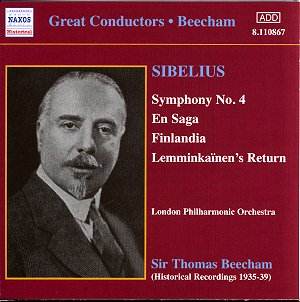Since Beechamís famous recording of Sibelius
4 was transferred to LP by A. C. Griffith and issued on World
Record Club around 1970 it has rarely been out of the catalogue
in one form or another. In 1991 the Griffith transfer appeared
on CD as part of EMIís Beecham Edition, coupled with the performances
of Lemminkaïnenís Return and The Bard which are also included
here, plus the Prelude to The Tempest and the 1947 version of
the Sixth Symphony.
Working presumably from the original metal masters
Griffith found slightly more body to the sound and a wider dynamic
range. He also reduced the surfaces more than has been done here,
producing results which, in the quieter passages, might lead the
innocent listener to suppose he is listening to a more recent
recording. But the first forte passage in the symphony produces
considerable distortion which is not present on the Naxos transfer
and the heavier passages of Lemminkaïnenís Return incline
towards shrillness.
I have sometimes criticised Mark Obert-Thorn
for trying to get too much out of these old recordings at the
cost of excessive stridency. In the present case he seems content
to offer a straightforward reproduction of what the original 78s
sounded like played on the best possible equipment. Any further
intervention has been done very discreetly. The sound has very
slightly less impact than the Griffith transfer, but it is also
smoother and has less distortion. In either transfer the softer
passages are remarkably detailed. By a small margin I prefer the
Naxos; not to the extent that you should go out and get it if
you have the performances in some other form but if you do not
you can safely buy this inexpensive disc.
And you should do so. Few records could demonstrate
better the dichotomy which still exists between Beechamís flippant
image and the dedicated musicianship of his actual conducting
Ė few records, that is, except for most of his others! Recording
music which was still relatively new his approach is totally free
of any playing to the gallery or egotistical distortion. His sombre
Finlandia can stand alongside his Scheherazade and his Symphonie
Fantastique as examples of his almost cynically underplaying an
old warhorse, and thereby making its musical values shine as few
others have since. It is also to be noted that the producer Walter
Legge sent test pressings of the Fourth to Sibelius who found
them "excellent"; any conductor could have felt well
satisfied but Beecham took the symphony into the studio again
in order to incorporate some small suggestions, including the
manufacture of a special set of bells to replace the more commonly
used glockenspiel. Since Sibeliusís own performances of his music
were not recorded, Beechamís poetic, majestic and vital visitation
of the score may be taken as definitive.
With a good note by Lyndon Jenkins (though I
would like to have known why En Saga was split between two venues
and two dates several months apart) this is a self-recommending
issue.
Christopher Howell
